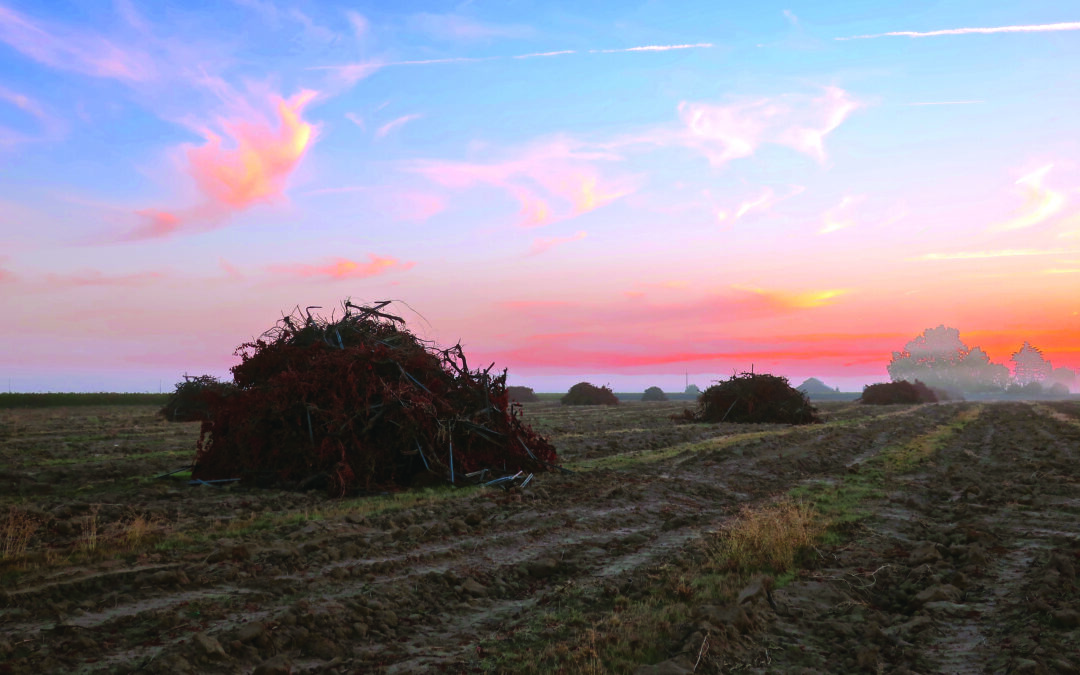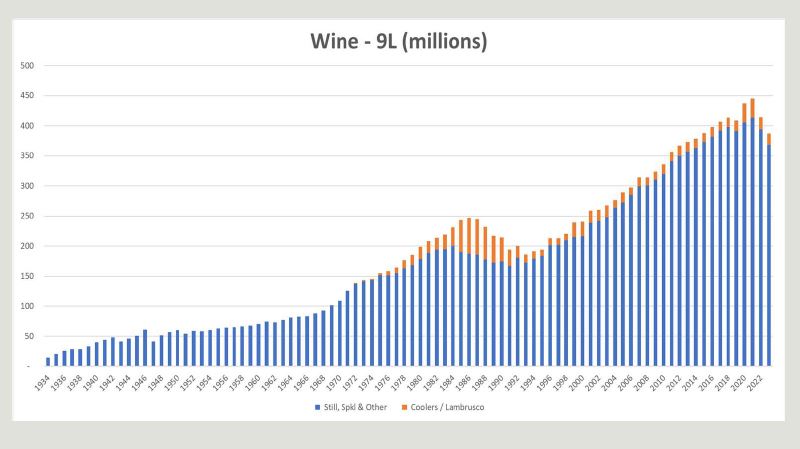MONDAY, FEBRUARY 5, 2024. BY STUART SPENCER, LODI WINEGRAPE COMMISSION.
At the Unified Wine & Grape Symposium’s State of the Industry presentation on January 24, Jeff Bitter with Allied Grape Growers recommended that California needs to remove a minimum of 50,000 acres of winegrapes to get supply better aligned with current demand. Bitter was even more specific, with the following regional recommendations:
- Lodi/Delta -15,000 acres
- Central Valley – 15,000 acres
- Central Coast, Mendocino, and Lake Counties – 15,000 acres
- Sonoma/Napa – 5,000 acres
I’ve also been told privately by other leading industry professionals that we likely need to remove 100,000 acres of winegrapes statewide. One of the challenges is that new acreage coming online is much more productive than the acres being pulled. Several industry presentations over the past month highlight the many significant challenges confronting the wine sector. Notably, after three decades of growth triggered by the French Paradox in 1991, U.S. wine shipments have experienced a consecutive two-year decline. Projections indicate that 2023 wine shipments may decrease by 2-4%.
Total Wine Shipments 1934-2023.Credit Gomberg, Fredrickson & Associates.
Additionally, the rapid rise of input and labor costs has driven up the cost of both farming and winemaking, reducing profitability all around. And under current market conditions, even finding a contract may be difficult. With current grape market prices being offered to growers, higher yields are necessary to maintain sustainable margins. And many of our older vineyards, still producing high-quality fruit, cannot produce the higher yields necessary with current pricing. Based on all the above, many growers may be considering alternative crops and vineyard removals.
VINEYARD REMOVAL CONSIDERATIONS
BEFORE vines are pushed over, piled up, or otherwise removed from the ground:
- Contact any financial incentive programs you’ll be applying for as they may need to visit the vineyard while it is still intact.
- Conduct any disease testing as required for the Tree Assistance Program (TAP) or the Ag Commissioner’s Office.
- Decide what you plan to use the land for next, which will help you decide how to dispose of the vines. The way you remove the vines (with or without wire/how they are piled) matters and can differ between disposal methods.
Agricultural Burning – There is a great deal of confusion regarding regulatory requirements for burning vineyards. The SJ Valley Air Pollution Control District is scheduled to outlaw all burning of vineyards by January 1, 2025. Currently, growers farming under 250 acres may still be able to get a permit to burn, but both burn day availability and the amount growers are allowed to burn per burn day are much more restrictive than in the past. Removing a vineyard without the use of open-air ag burning is much more expensive, and vineyard removals are likely to be more costly and expensive down the road. For additional information please visit CLEARING THE AIR: AG BURNING OUTREACH MEETING and check out the 14-page main meeting handout, which includes the phase-out schedule, financial incentive information, vineyard removal tips and resources, best practices for burning alternatives, and TAP-approved crops for rotation.
Tree Assistance Program (TAP) – The Tree Assistance Program, or TAP for short, provides financial assistance to eligible growers experiencing a natural disaster, such as greater than 15% infection with red blotch or leafroll virus, using funds from the Farm Bill. You may be eligible to recoup up to 65% of certain removal and replanting costs. And you do not need to replant with winegrapes. There is an extensive list of TAP-approved alternative crops. For more information, visit our PULLING OUT A VINEYARD? READ THIS FIRST blog.
Property Taxes – Once a vineyard is removed from production, growers may be able to have the county reassess the property for a reduction in property taxes.
Land Values – Several factors may make bare land more valuable for resell or lease. Older or diseased vineyards may be difficult to farm profitably without higher yields or a premium buyer.
Lease Options – There may be opportunities to lease your land to other agricultural operations. In some cases, land renters may be willing to remove existing vineyards as part of the lease agreement. If interested, contact local ag real estate companies to explore options.
Disease Issues – Many vineyard pests and diseases pose a threat to neighboring vineyards, future vineyards, and the Lodi region as a whole, especially vine mealybugs, leafroll virus, powdery mildew, noxious weeds, and trunk disease. Leaving a vineyard unmanaged could exacerbate disease issues for neighboring vineyards and reduce the lifespan, and thus profitability, of nearby vineyards.
Fallowing Ground – Fallowing the ground might be the best strategy for future opportunities. Allowing the ground to rest with a well-thought-out cover crop can help regenerate the soil and improve the health of crops planted later on.
Crop Rotation – Crop rotation should be considered especially on 2nd and 3rd generation vineyards. Crop rotation promotes long-term soil health, improves productivity, reduces environmental impact, and supports a more resilient and sustainable agricultural system. Larger ranches may want to consider a plan to rotate vineyards across the available acreage, possibly incorporating livestock as a secondary income source.
Alternative Crops – Many alternative crops can thrive in Lodi. Our soils, Mediterranean climate, and reliable access to water provide lots of options. Diversifying your farming operation helps manage risk and provides new revenue streams. Some crops might be niche specialty crops that require a hand-sell, but they could also open the door to other opportunities and breathe new life into your farming operation. If you are considering planting trees, it is advisable to contact your local water agencies to understand long-term water availability for your site as trees use more water than vines. For more information visit, Woodbridge Irrigation District and North San Joaquin Water Conservation District.
We understand that removing a vineyard can be a tough and very personal decision. If you are uncertain how to proceed and would like to discuss your options, please feel free to reach out to the Lodi Winegrape Commission. Stuart Spencer, Executive Director, and Dr. Stephanie Bolton, Research & Education Director, are happy to sit down one-on-one with you to talk about market conditions and help you think through ideas for moving forward. We can be reached at 209.367.4727.
Have something interesting to say? Consider writing a guest blog article!
To subscribe to the Coffee Shop Blog, send an email to stephanie@lodiwine.com with the subject “blog subscribe.”
To join the Lodi Growers email list, send an email to stephanie@lodiwine.com with the subject “grower email subscribe.”
To receive Lodi Grower news and event promotions by mail, send your contact information to stephanie@lodiwine.com or call 209.367.4727.
For more information on the wines of Lodi, visit the Lodi Winegrape Commission’s consumer website, lodiwine.com.
For more information on the LODI RULES Sustainable Winegrowing Program, visit lodigrowers.com/standards or lodirules.org.



